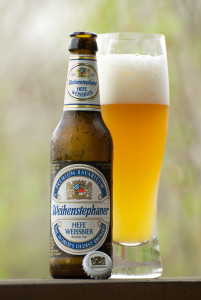Every year at this point in April, regardless of weather, Ohioans pull on their shorts. Many of these bare and vulnerable legs are an alarming shade of white, which one is well-advised to not look at directly. Ohio winters are long, and at this point we’ve watched all of Netflix and need to get out of the goddamned house. We will sit at a picnic table in a parka and Daisy Dukes, if it comes to that, because it’s time to be outside.
I can’t say this Ohio beer-lover in particular is willing to reveal her alabaster gams, but she is ready for other summer activities, namely, summer beers. The breweries are way ahead of me, and summery wheat beers are already well-represented on the shelves and at the taps. Wheat beers are, by some magic of chemistry, delightfully refreshing, and thus often the style of choice for brewers making a warm-weather seasonal.
So, what is a wheat beer? Well, beer folk are notoriously non-obfuscationary, so your guess that wheat beers are brewed largely with wheat, instead of just barley alone, would be correct. In brewing they are top fermented and bottled conditioned. They are easy to pick out in a crowd: they’re unfiltered, hazy, and have a thick head; their smell will likely be of fruit or cloves; and they wear skinny jeans with slouchy hats while leaning against walls and playing on their phones.
That information I felt pretty confident with; it was the further branching of this definition that left me similarly hazy and thick-headed. What was the difference between wheat beers like Hefeweizen, white beer, witbier, weissbier, etc? Don’t worry: I know how to use The Google — I now can tell you what the difference is.
Essentially there are two types of wheat beers: one originating in Germany (weissbier) and one originating in Belgium (witbier). Germany’s weissbiers are known more commonly as Hefeweizens. These come in a wider range of colors than the witbier, stretching from very pale to a rich gold. The witbiers are so named (“white beer,” for the record) because they look white, an effect caused by the suspended yeast and leftover wheat bits.
The smell and taste is where you can best tell the difference between the two types of wheat beers. Hefeweizens are often accused of having — and here comes my favorite beer vocab word, ever — banana nose. Banana nose! When you stick your own nose down in one of those tall hefe glasses you will almost definitely get a whiff of banana. But don’t fret: no bananas were injured in the brewing of this beer.
Witbiers are less fruity, more sweet and spicy — more like sticking your nose into one of those shops that smells Christmas junk all year long…but less abrasive and soul crushing. They were originally brewed without hops at all, instead using fruit and spice. Today some hops are usually thrown in there, but with some fruit and spices also, remaining true to its origins, again, unlike Christmas.
The same general principles apply to the taste: hefes are fruitier with strong notes of clove; witbiers are spicier and more citrusy. The banana nose in the German style comes from the particular strain of yeast. The witbier’s flavor comes from the added ingredients, most commonly coriander and orange peel.
And now the issue of fruit. Never before has a wedge of citrus proven so controversial and inspired such vitriol. Some beer-lovers like the added citrus kick from a spiral of orange or lemon in their wheat beer. Others will refuse to speak to you again if they see you with citrus in your beer. These are the beer-lovers who wave their hands at the bartender saying derisively, skip the fruit. Their argument: citrus can overwhelm the subtle notes in wheat beers and adversely affect their trademark head [insert your own head joke here].
But fruit or no fruit, it’s time to pull on your cut-offs, jams, short-shorts — even skorts are acceptable — and get outside with a refreshing brew. Nothing says 54-degrees like tank tops and wheat beers.





http://hoegaarden.com/beer/hoegaarden/
One of my favorites